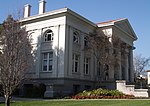Claremont High School (California)
1964 establishments in CaliforniaClaremont, CaliforniaEducational institutions established in 1964International Baccalaureate schools in CaliforniaPublic high schools in Los Angeles County, California
Claremont High School is a public high school in Claremont, California, United States. Part of the Claremont Unified School District, it is a California Distinguished School, a two-time national Blue Ribbon School of Excellence (1986–1987, 1999–2000), and a nationally recognized International Baccalaureate (IB) World School.The school serves Claremont and a small section of Pomona.
Excerpt from the Wikipedia article Claremont High School (California) (License: CC BY-SA 3.0, Authors).Claremont High School (California)
Indian Hill Boulevard,
Geographical coordinates (GPS) Address Phone number Website Nearby Places Show on map
Geographical coordinates (GPS)
| Latitude | Longitude |
|---|---|
| N 34.112777777778 ° | E -117.72361111111 ° |
Address
Claremont High School
Indian Hill Boulevard 1601
91711
California, United States
Open on Google Maps







